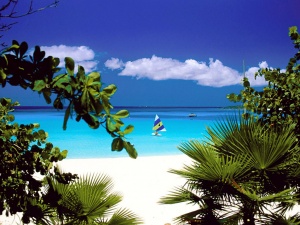This post may contain affiliate links. We may earn money or products from the highlighted keywords or companies or banners mentioned in this post.
 If you're looking for a pitch that's tailor-made for Millennial clients, the Trinidad & Tobago Tourism Development Company has rounded up five reasons to travel to the islands to share with your younger clients.
If you're looking for a pitch that's tailor-made for Millennial clients, the Trinidad & Tobago Tourism Development Company has rounded up five reasons to travel to the islands to share with your younger clients.
“As this generation is seeking more than the traditional ‘sun, sand and sea’ vacation the dual-island nation, with excursions including hiking, snorkeling, diving, fishing, ‘party-boating’, exploring limestone caves, zip lining and more, will send Millennials home with unforgettable stories to share,” said Warren Solomon, general manager of marketing at the Trinidad & Tobago Tourism Development Company.
Here are the TDC's five reasons why Trinidad & Tobago is so attractive to Millennials in 2015:
1. Travel App – Technology has become an important platform for travel research and planning, especially among Millennials, making travel apps not only an added convenience but a necessity. The destination introduced a new travel app in late 2014 that allows travelers to use it offline (the better to avoid roaming data charges), find their way on an interactive map, check local hotel and restaurant pricing, ratings and contact information, find information on local attractions and browse through a photo gallery. The Trinidad & Tobago Travel App comes preloaded on all Samsung Smart TVs and can be downloaded onto smart devices via Apple and Google stores.
2. Eco-adventure – On Tobago, which is known for its unspoiled beaches and great weather, travelers can hike the oldest protected reserve in the Western Hemisphere, The Main Ridge Rainforest. Additionally, the island has a large population of hawksbills living in its numerous coral reefs and many green turtles inhabit the sea grass beds off the coast. With 80 percent of all leatherback nesting in the insular Caribbean, both islands offer a near guarantee to witness giant sea turtles on beaches from March through September. Adventure seekers can go zip lining to get a bird’s eye view of Trinidad while soaring 100 feet in the air across seven different zip lines through Macqueripe Bay. For more information, contact Zipitt at 1-868-303-7755 or email [email protected]. Departing from Chaguaramas Heritage Park, “Down the Islands” is a day trip for groups to explore the Gasparee Caves and the collection of off-shore vacation islands. Lying below the ground, these limestone caves have a mysterious crystal clear pool, perfect for swimming. For information on these tours and more, contact the Trinidad & Tobago Incoming Tour Operators Association.
3. Watersports – Home to the largest brain coral in the world, Tobago offers underwater appeal with fascinating coral formations, countless fish and exceptional water conditions. Divers can catch a glimpse of barracudas, dolphins, whale sharks, turtles, porpoises, butterfly fish, queen and French angels and parrotfish. Paddleboard novices can head to Pigeon Point Heritage Park in Tobago and visit Stand Up Paddle Tobago for personalized instruction on all the basic skills, including board balance and paddle technique. Surfers can “hang ten” with Trinidad and Tobago Surf Experience, located on both islands, for top-notch surf experiences. Those who prefer wind or kitesurfing can visit Radical Water Sports, Tobago’s professional windsurf center, also located at Pigeon Point. Those more interested in soaking up the sun can hop on a glass bottom boat at Pigeon Point for a tour through Buccoo Reef. They can choose to jump in and snorkel or simply soak up the sun and views. Near Buccoo Reef, travelers will find the clear, shallow turquoise waters of nylon pool ideal for swimming. After a brief swim in nylon pool, groups can opt for a barbeque and beach party accompanied by soca music on No Man's Land, a sandy island of white coral-sand jutting into the lagoon.
4. Authentic Cultural Experiences – Millennials seeking local, authentic experiences can immerse themselves in the destination’s vibrant culture through food and music. With culinary influences from India, Africa, Asia and Europe, the local gastronomy is a melting pot of flavors. With 40 percent of the Trinidadian population being East Indian, many of the local dishes feature pungent curry spices like Cumin, Masala, Madras and Turmeric. When visiting Trinidad, visitors don’t want to miss out on:
– Doubles – a sandwich made with fried flat bread filled with curried chickpeas
– Roti – meat or vegetables in curry sauce, wrapped in pita-like pastry
– Bake & Shark – a Trinidadian native dish that consists of deep-fried shark stuffed in a pocket of deep-fried batter, a bread somewhat similar to the Native American “fry bread”
– Curry crab and dumplings is the staple dish for visitors in Tobago and can be found at many restaurants around the island
Trinidad & Tobago is also the birthplace of the steel pan (the only instrument invented in the 20th Century), soca and calypso music. Steel pan bands can be seen practicing at various locations throughout the island year round.
5. Festivals – Although best known for its Carnival celebration, the cultural diversity of the nation is reason for year-round festivals. Tobago Heritage Festival celebrates traditions that are mostly African, with the main event, the traditional “Ole Time Wedding,” taking place in the village of Moriah. Beginning this July 17 with fetes culminating in a J’ouvert and street parade on Emancipation Day (August 1), Tobago Heritage Festival is one of the most important celebrations of the year for Tobago. Tobago also hosts the Blue Food Festival. It is an annual festival where local chefs and creative, indigenous cooks come together to share their knowledge, cooking secrets and tasty blue creations with commonly-used local ingredient dasheen, the Caribbean root vegetable that turns blue when cooked. Chefs compete against one another to create the best appetizers, entrees, desserts and even wine with this unique ingredient every October. Because of Trinidad’s large East Indian influence, the nation’s Hindu festivals, customs and traditions form an integral part of society. The celebration of Divali, also called Hindu Festival of Lights, is the perfect time for Millennials to immerse themselves in Hindu religion and culture.










